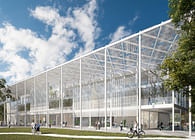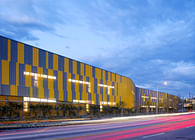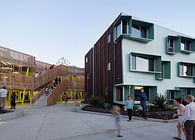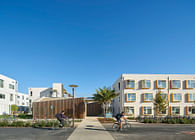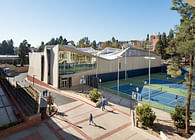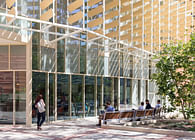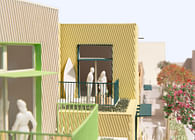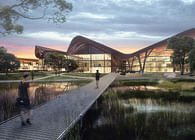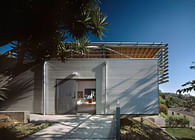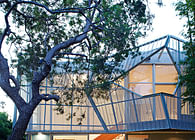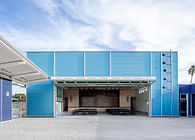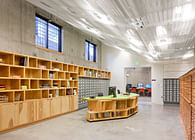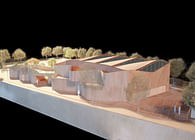
Los Angeles, CA | New York, NY
Recognized internationally as one of the best design schools in the country, Art Center College of Design’s campus has been tucked away into Pasadena’s Linda Vista Hills for over thirty years. Richard Koshalek, the president of the school, began an ambitious plan to develop a satellite campus near the center of Pasadena’s downtown. In so doing, the school came “down from the acropolis to…a gritty industrial neighborhood,” which it means to transform in part as “a way of bringing the school directly to the city.” The first in a planned series of buildings is the Graduate Fine Arts & Public Education, or South Campus, Building.
The original building complex was built by Caltech after World War II for a consortium of five aircraft companies and was called the Southern California Cooperative Wind Tunnel. It was upgraded in the mid-’50s to house one of the world’s first giant supersonic wind tunnels. But in the 1960s, the building was taken over by the Dacor Corporation, an appliance manufacturer, which used the central structure as its main factory and added additional work structures. The building had very few windows or access to the street and a convoluted floor plan. The immediate design goal was to create physical connections among the main wind tunnel building, the accessory structures, its activities, and passers-by on the street while reflecting the school’s own history of innovation by using technological advances in both design and engineering.
The exterior was simply sandblasted to reveal the original raw materiality and strong building volumes. Key to the success of the project was the development of a rational and intuitive way-finding system to replace the difficult circulation problems of the existing structures. New partitions form flexible teaching spaces that can be used for graduate students as well as public education. At the entrance a new exterior sculptural stair provides visual focus and easy access to every level of the building.
The existing building posed both a challenge and an opportunity. The wind tunnel’s complex of concrete buildings had few windows and large, uneven, dark spaces. To open up the building, windows and skylights were cut into the thick street-front concrete walls and the roof, bringing light into classrooms and studios while making the program visible to the street. Three large strategic cuts were made in the roof to form the base of the sculptural skylights that were custom designed by the architects in collaboration with graphic designer Bruce Mau, ARUP structural engineers and Foiltec technicians. The skylight system is built of translucent ETFE films stretched on a custom-designed structural frame. Three thin printed layers of Foiltec (a Teflon-coated polymer) comprise the pillows within the structural frame. Via compressors these layers are inflated or deflated to adjust the amount of natural light and heat entering the building. These sculptural elements rest in the roof top garden of native grasses and form the boundaries of what is now the campus quad.
The building is among the first in Pasadena to be granted LEED certification from the U.S. Green Building Council and one of the first renovated buildings in the country to achieve certification. The Graduate Fine Arts & Public Education Building has transformed a dark industrial space inhospitable to teaching the fine arts into a creative educational facility and cultural center open to all Southern California residents.
Status: Built
Location: Pasadena, CA, US
Additional Credits: First three photos by Benny Chan
Fourth photo by Nic Lehoux
Fifth photo by Grant Mudford
